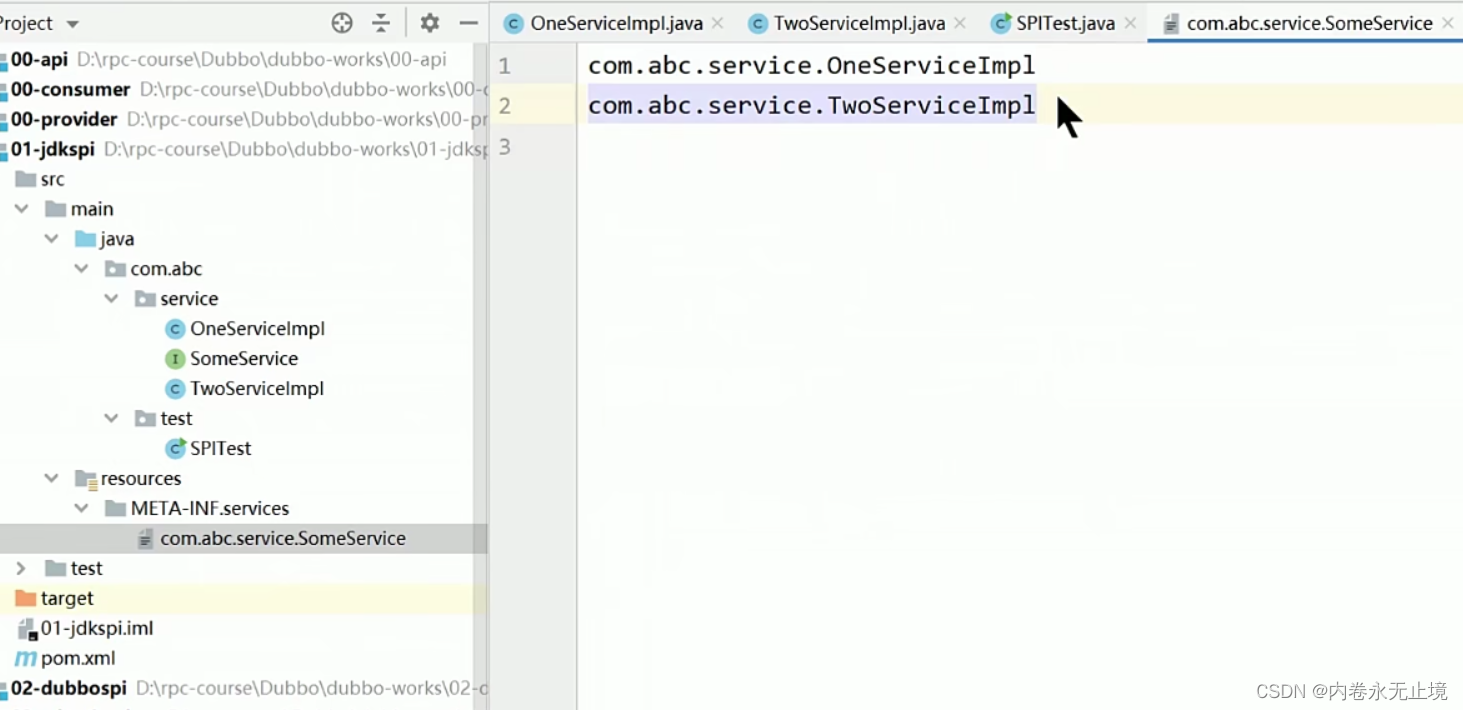一.jdk
//获取cpu核数Runtime.getRuntime().availableProcessors()//扩容为当前两倍Cell[] rs = new Cell[n << 1];//寻址tab[i = (n - 1) & hash])//返回Java虚拟机中的堆内存总量long initialMemory = Runtime.getRuntime( ).totalMemory();返回java虚拟机试图使用的最大堆内存量long maxMemory = Runtime.getRuntime( ).maxMemory();//输出响应内容PrintWriter out = response.getWriter();out.print(configInfoBase.getContent());out.flush();out.close();//输出文件内容File file = new File("test");file .getChannel().transferTo(0L, fis.getChannel().size(), Channels.newChannel(response.getOutputStream()));//判断是否是父子关系,结果是true,证明B可以转换成AA.isAssignableFrom(B)
1.1创建单例的两种方式
①.双重检锁+volatile
public class VolatileTest {private static volatile VolatileTest sinleton;private VolatileTest(){}public static VolatileTest getInstance(){if (sinleton == null){synchronized (sinleton){if (sinleton == null) {//1.分配内存空间 2.初始化对象 3.设置instance指向刚分配的内存地址//如果不加volatile修饰可能会导致2和3顺序对调sinleton = new VolatileTest();}}}return sinleton;}}
②.静态内部类
public class VolatileTest {private VolatileTest(){}private static class VolatileHolder{private static final VolatileTest INSTANCE = new VolatileTest();}public static VolatileTest getInstance(){return VolatileHolder.INSTANCE;}}
1.2jdk的spi机制
在resources下META-INFO的services目录下定义接口的全路径接口名,在文件里定义实现类的全路径名,一个一行。使用ServiceLoader.load(接口类)获取实现类

1.3获取ip地址
public static String getRemoteIp(HttpServletRequest request) {String xForwardedFor = request.getHeader("X-Forwarded-For");if (!StringUtils.isBlank(xForwardedFor)) {return xForwardedFor.split(",")[0].trim();}String nginxHeader = request.getHeader("X-Real-IP");return StringUtils.isBlank(nginxHeader) ? request.getRemoteAddr() : nginxHeader;}
二.Nacos
字符串null转换为""this.logName = Objects.toString(this.logName, "");
2.1获取ip信息
#获取ip信息commons.util工具类InetUtils inetUtils;this.ip = this.inetUtils.findFirstNonLoopbackHostInfo().getIpAddress();#网络接口名在大多数操作系统上(包括Windows、Linux和Unix)是以eth开头,后面是网络接口的索引号,从0开始。如本机安了三块网卡,那么网络接口名就依次是eth0、eth1和eth2.NetworkInterface对象的toString方法可以返回网络接口的名称、显示名和这个网络接口上绑字的所有IP地址等信息NetworkInterface netInterface = NetworkInterface.getByName(this.networkInterface);
2.2创建观察者
#创建观察者public class NacosWatch implements ApplicationEventPublisherAware, SmartLifecycle {private static final Logger log = LoggerFactory.getLogger(NacosWatch.class);private final NacosDiscoveryProperties properties;private final TaskScheduler taskScheduler;private final AtomicLong nacosWatchIndex;private final AtomicBoolean running;private ApplicationEventPublisher publisher;private ScheduledFuture<?> watchFuture;private Set<String> cacheServices;private HashMap<String, EventListener> subscribeListeners;public NacosWatch(NacosDiscoveryProperties properties) {this(properties, getTaskScheduler());}public NacosWatch(NacosDiscoveryProperties properties, TaskScheduler taskScheduler) {this.nacosWatchIndex = new AtomicLong(0L);this.running = new AtomicBoolean(false);this.cacheServices = new HashSet();this.subscribeListeners = new HashMap();this.properties = properties;this.taskScheduler = taskScheduler;}private static ThreadPoolTaskScheduler getTaskScheduler() {ThreadPoolTaskScheduler taskScheduler = new ThreadPoolTaskScheduler();taskScheduler.initialize();return taskScheduler;}}
2.3反射
#反射创建类public static NamingService createNamingService(Properties properties) throws NacosException {try {Class<?> driverImplClass = Class.forName("com.alibaba.nacos.client.naming.NacosNamingService");Constructor constructor = driverImplClass.getConstructor(Properties.class);NamingService vendorImpl = (NamingService)constructor.newInstance(properties);return vendorImpl;} catch (Throwable var4) {throw new NacosException(-400, var4);}}
2.4心跳定时任务
/*** nacos心跳定时任务*/@Slf4jpublic class BeatThread {private ScheduledExecutorService executorService;public void task(){log.info("进入task中");executorService = new ScheduledThreadPoolExecutor(1, new ThreadFactory() {@Overridepublic Thread newThread(Runnable r) {Thread thread = new Thread(r);thread.setDaemon(true);thread.setName(String.valueOf(new Random().nextInt(10)));return thread;}});executorService.schedule(new BeatTask(),1,TimeUnit.SECONDS);}class BeatTask implements Runnable {public BeatTask() {}@Overridepublic void run() {log.info("进入线程任务中了");executorService.schedule(new BeatTask(),1,TimeUnit.SECONDS);}}}
2.5故障转移
public String reqAPI(String api, Map<String, String> params, List<String> servers, String method) {params.put("namespaceId", this.getNamespaceId());if (CollectionUtils.isEmpty(servers) && StringUtils.isEmpty(this.nacosDomain)) {throw new IllegalArgumentException("no server available");} else {Exception exception = new Exception();if (servers != null && !servers.isEmpty()) {Random random = new Random(System.currentTimeMillis());int index = random.nextInt(servers.size());for(int i = 0; i < servers.size(); ++i) {String server = (String)servers.get(index);try {return this.callServer(api, params, server, method);} catch (NacosException var11) {exception = var11;LogUtils.NAMING_LOGGER.error("request {} failed.", server, var11);} catch (Exception var12) {exception = var12;LogUtils.NAMING_LOGGER.error("request {} failed.", server, var12);}index = (index + 1) % servers.size();}throw new IllegalStateException("failed to req API:" + api + " after all servers(" + servers + ") tried: " + ((Exception)exception).getMessage());} else {int i = 0;while(i < 3) {try {return this.callServer(api, params, this.nacosDomain);} catch (Exception var13) {exception = var13;LogUtils.NAMING_LOGGER.error("[NA] req api:" + api + " failed, server(" + this.nacosDomain, var13);++i;}}throw new IllegalStateException("failed to req API:/api/" + api + " after all servers(" + servers + ") tried: " + ((Exception)exception).getMessage());}}}

